It was a somber atmosphere Saturday morning when I cast off before 9: gray skies and brown marsh, in stark contrast to the blue skies and golden marshes of my last sail, seemingly a long time ago. Water covered ground where the tide rarely visits. 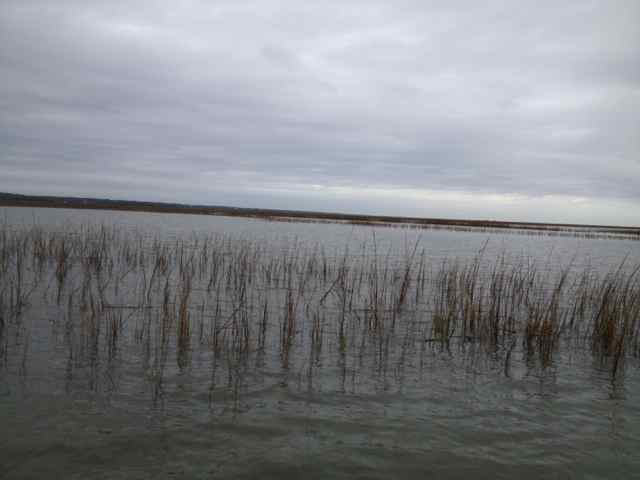 Sailing out Andersonville Creek, and heading to the public dock on Bull Island, I was tempted to cut across the several miles of marsh as the cormorant flies, but I knew what the result would be. I’ve been mired in marshes before, dragging small boats through pluff mud and cordgrass, in both winter and summer. The mouth of Andersonville Creek was a foreign world, with the usual banks covered, and leaving more water than landmarks. I had planned to shorten my trip across Bulls Bay and into Bull Creek by using the passage over Shortcut Shoal, but I found myself cutting the corner even further by navigating across the submerged marsh, passing through the top tips of the longest cordgrass. I paralleled the bank where shells were piled in “rakes”, aware with the northeast wind that within ten yards was a lee shore, but at the moment a benevolent one. A shallow “bay” stretched out over the marsh beyond the tenuous bank, populated periodically by great blue herons, their color mirroring the day. A crabber appeared ahead in Bull Creek, his deck piled with yellow crab pots; in a minute I bore off heading southwest in Bull Creek. The downwind sail brought me to the landing an hour after casting off from the mainland. It was a dock transformed by the high tide, with only nubs of concrete pilings protruding above the floating rafts, and a walkway inverted from its usual angle.
Sailing out Andersonville Creek, and heading to the public dock on Bull Island, I was tempted to cut across the several miles of marsh as the cormorant flies, but I knew what the result would be. I’ve been mired in marshes before, dragging small boats through pluff mud and cordgrass, in both winter and summer. The mouth of Andersonville Creek was a foreign world, with the usual banks covered, and leaving more water than landmarks. I had planned to shorten my trip across Bulls Bay and into Bull Creek by using the passage over Shortcut Shoal, but I found myself cutting the corner even further by navigating across the submerged marsh, passing through the top tips of the longest cordgrass. I paralleled the bank where shells were piled in “rakes”, aware with the northeast wind that within ten yards was a lee shore, but at the moment a benevolent one. A shallow “bay” stretched out over the marsh beyond the tenuous bank, populated periodically by great blue herons, their color mirroring the day. A crabber appeared ahead in Bull Creek, his deck piled with yellow crab pots; in a minute I bore off heading southwest in Bull Creek. The downwind sail brought me to the landing an hour after casting off from the mainland. It was a dock transformed by the high tide, with only nubs of concrete pilings protruding above the floating rafts, and a walkway inverted from its usual angle.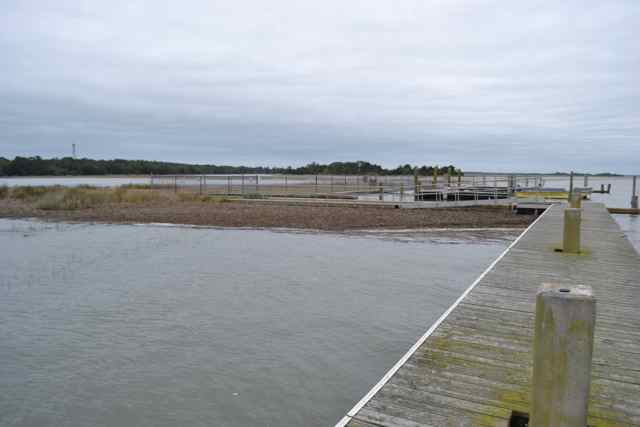
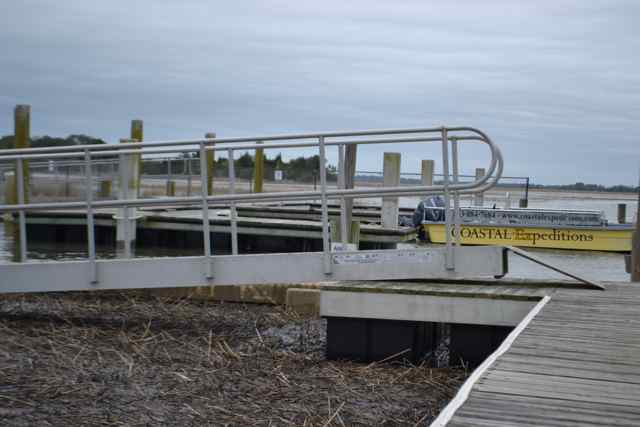 10 AM was the start of my Jacks Creek walk-around, heading up Old Fort Road, east on Big Pond Road, and then north on Sheepshead Ridge Road to another turn to the east on Alligator Alley. Some freshly fallen leaves from a Chinese tallow signaled that the battle with this invasive was not over.
10 AM was the start of my Jacks Creek walk-around, heading up Old Fort Road, east on Big Pond Road, and then north on Sheepshead Ridge Road to another turn to the east on Alligator Alley. Some freshly fallen leaves from a Chinese tallow signaled that the battle with this invasive was not over. 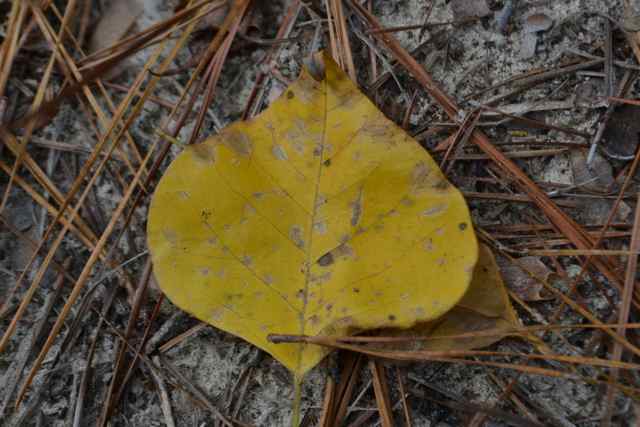 Always anticipating the wildlife attracted to pool #2, I treaded softly, and was not disappointed. Despite the overcast conditions, alligators were basking with the promise of more solar radiation.
Always anticipating the wildlife attracted to pool #2, I treaded softly, and was not disappointed. Despite the overcast conditions, alligators were basking with the promise of more solar radiation.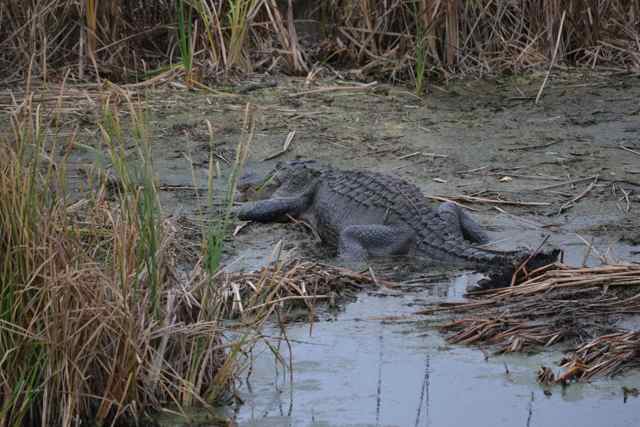
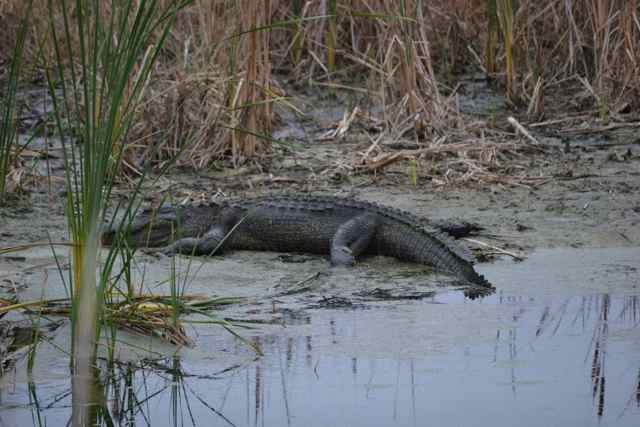 Off to the left of the dike the view into Jacks Creek was populated with a mass of birds, white being the primary color, and large congregations worked along the edges.
Off to the left of the dike the view into Jacks Creek was populated with a mass of birds, white being the primary color, and large congregations worked along the edges. 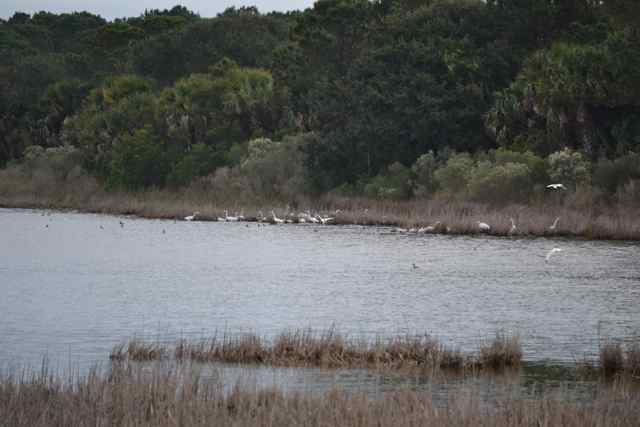 Continuing Alligator Alley around toward pool #3, I turned left instead of to the right on the road, hoping to spot the bird assembly. I followed the well-worn track of alligators the short distance to the edge of Jacks Creek, and found the gathering. I spooked the mass and they went aloft, filling the air in front of me.
Continuing Alligator Alley around toward pool #3, I turned left instead of to the right on the road, hoping to spot the bird assembly. I followed the well-worn track of alligators the short distance to the edge of Jacks Creek, and found the gathering. I spooked the mass and they went aloft, filling the air in front of me. 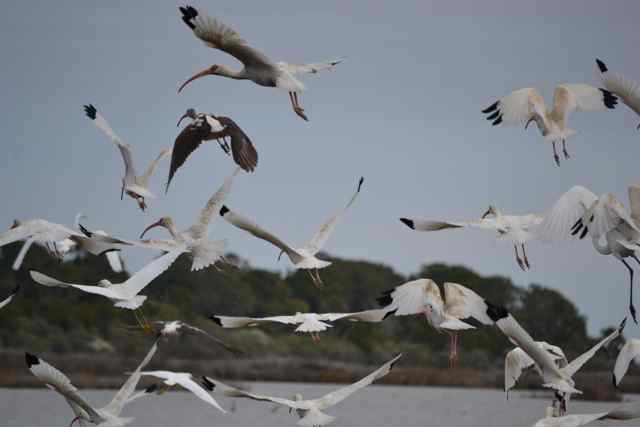 Hooded mergansers stuck around after the flight of the wading birds.
Hooded mergansers stuck around after the flight of the wading birds. 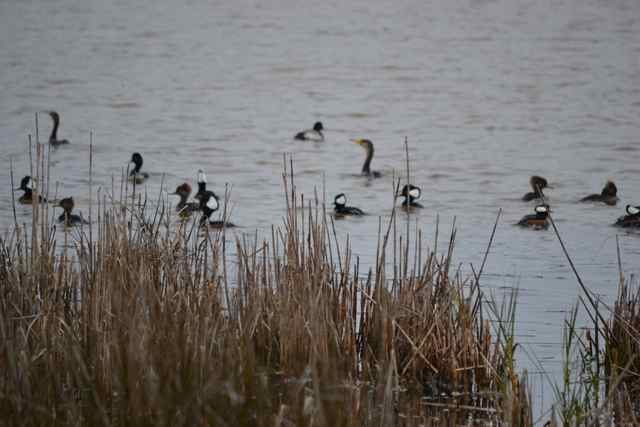 Backtracking to the road, another group appeared ahead by a water control structure, a large gathering of ibis, both white and glossy. They allowed a closer than expected approach before flying off.
Backtracking to the road, another group appeared ahead by a water control structure, a large gathering of ibis, both white and glossy. They allowed a closer than expected approach before flying off.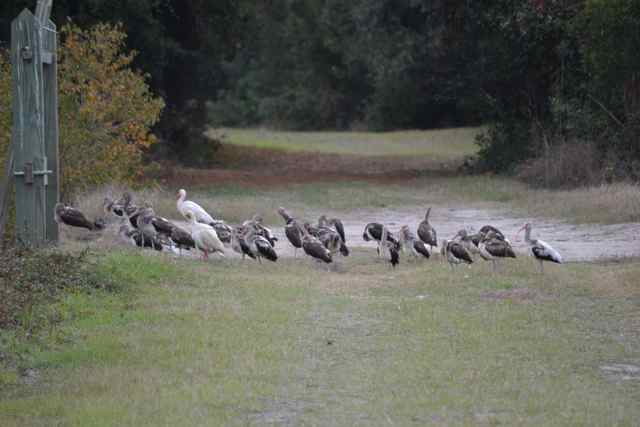
I took a look at Moccasin Pond, and noted the increased amount of water present. 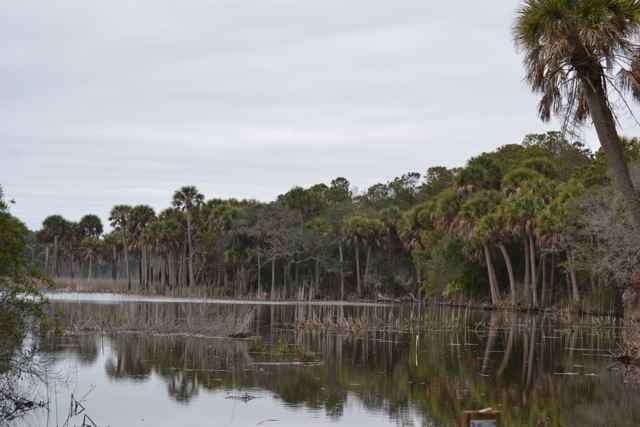 Gates Roll, a guide for Coastal Expeditions, had told me earlier that this area was changing dramatically along the eroded shore; I had observed on a past trip that a slough was bringing the sea to this natural pond at the highest tides. Next was a finger of Jacks Creek next to a high berm along the road, and various birds were fishing here, including a great blue heron and a cormorant making a get-a-way.
Gates Roll, a guide for Coastal Expeditions, had told me earlier that this area was changing dramatically along the eroded shore; I had observed on a past trip that a slough was bringing the sea to this natural pond at the highest tides. Next was a finger of Jacks Creek next to a high berm along the road, and various birds were fishing here, including a great blue heron and a cormorant making a get-a-way. 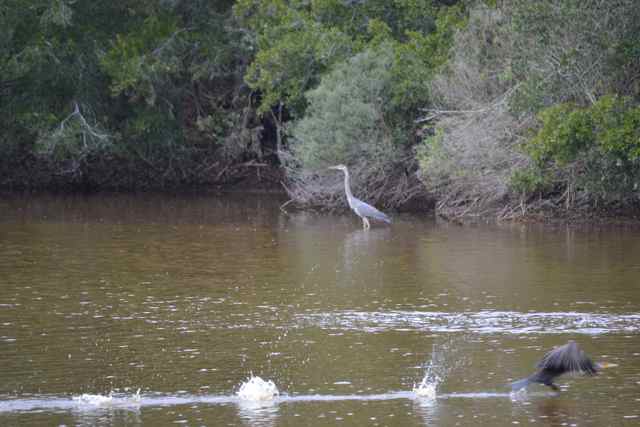 On toward the Boneyard, a familiar gator was at his usual basking spot by the berm, and was not troubled by my photographing presence.
On toward the Boneyard, a familiar gator was at his usual basking spot by the berm, and was not troubled by my photographing presence.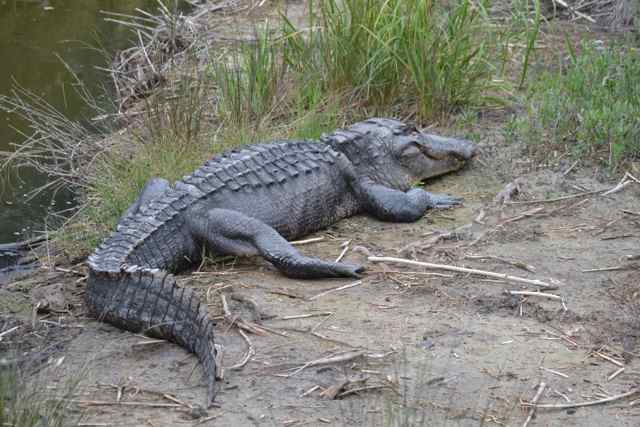
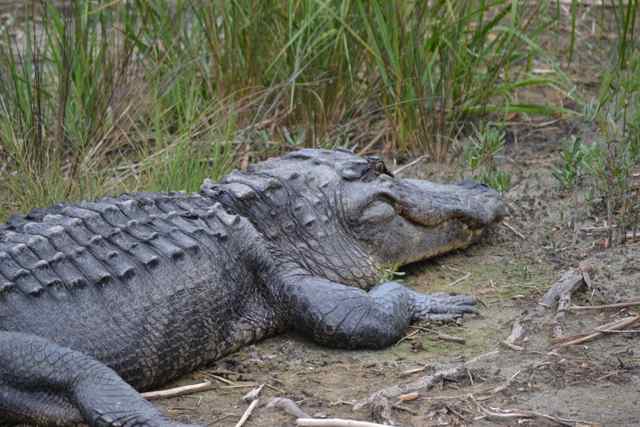 Even 2.5 hours after high tide, there was still little beach at the Boneyard. All continued to be gray around the shore – sunken trees, roosting cormorants, and the ocean.
Even 2.5 hours after high tide, there was still little beach at the Boneyard. All continued to be gray around the shore – sunken trees, roosting cormorants, and the ocean. 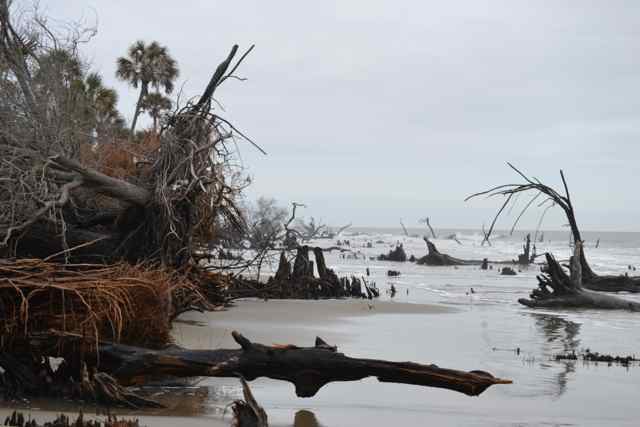
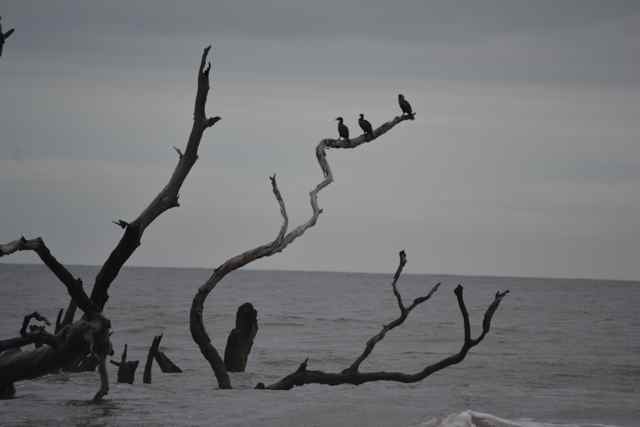 After a short jaunt north along the narrow beach, noticing new changes, I eyed the opening toward the dike, and took it.
After a short jaunt north along the narrow beach, noticing new changes, I eyed the opening toward the dike, and took it.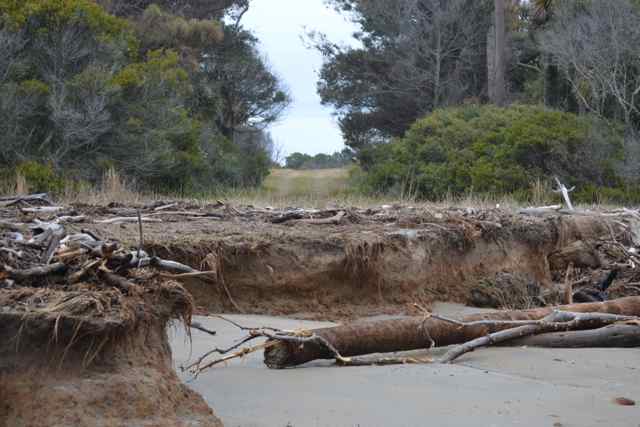
Picking up the pace, I walked along the Jacks Creek dike where it turns from northwest to northeast. Between the dike and the beach stand some dead trees, and perched on one was a large raptor. 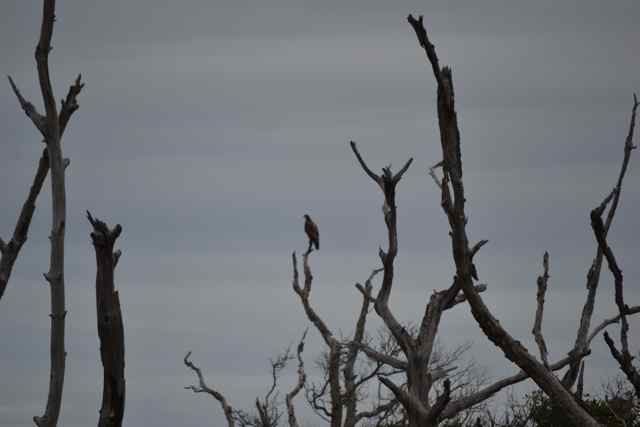 A closer approach would have meant wading out through the marsh. I zoomed my camera as close as possible, and wished for more sunlight to reveal the bird’s identity, but I could only make out what it was not – a mature bald eagle or vulture. I came to the closest proximity of ocean to dike, and having observed the change in this place over the last decade, I thought “when” and maybe “sooner” rather than “if” the breach will come.
A closer approach would have meant wading out through the marsh. I zoomed my camera as close as possible, and wished for more sunlight to reveal the bird’s identity, but I could only make out what it was not – a mature bald eagle or vulture. I came to the closest proximity of ocean to dike, and having observed the change in this place over the last decade, I thought “when” and maybe “sooner” rather than “if” the breach will come.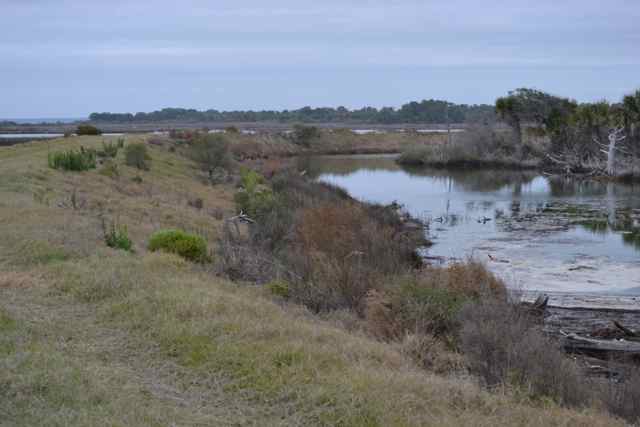
Birdlife continued to be abundant in Jacks Creek: ibis probed the edge of a marsh island, while mergansers cruised across the smooth waters. 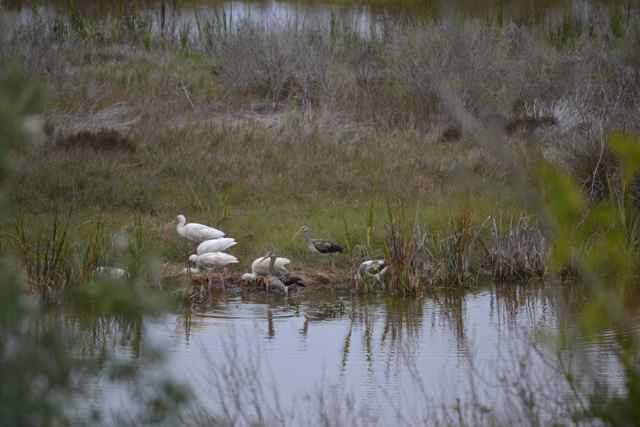 A stand of toothache trees formed a gray palisade on the each of the dike, and another younger tree had not shed its leaves.
A stand of toothache trees formed a gray palisade on the each of the dike, and another younger tree had not shed its leaves. 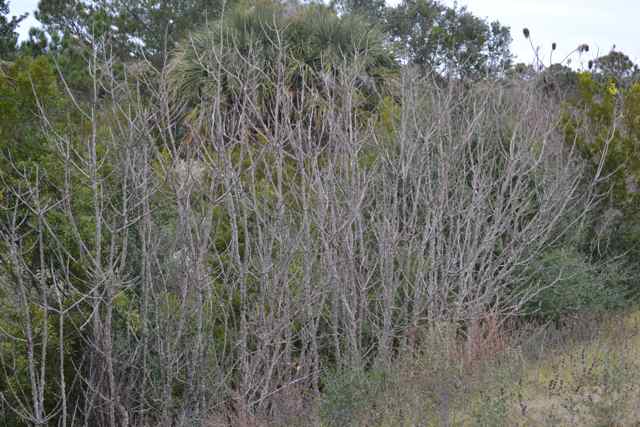
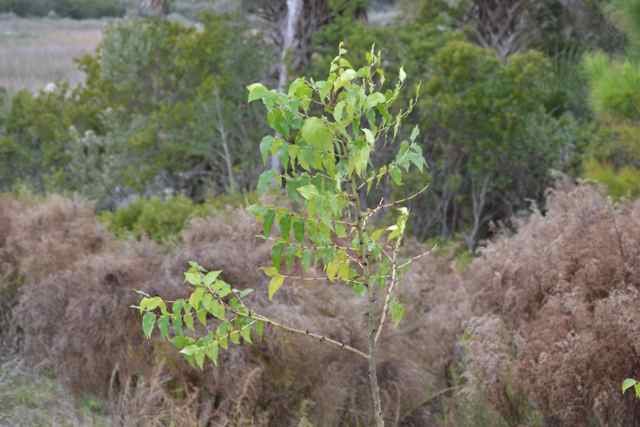 Ahead I saw three people approaching, and I recognized Gates and a couple on the middle day of the Bulls Island Multi-day Expedition. I asked if they had seen the immature bald eagle that flew north from my contact, and instead had observed a mature bald eagle in a tree. Earlier in the day the couple had also seen an otter in an impoundment with a snake in its jaws. Wishing them further good fortune for the rest of the weekend, we went our separate ways.
Ahead I saw three people approaching, and I recognized Gates and a couple on the middle day of the Bulls Island Multi-day Expedition. I asked if they had seen the immature bald eagle that flew north from my contact, and instead had observed a mature bald eagle in a tree. Earlier in the day the couple had also seen an otter in an impoundment with a snake in its jaws. Wishing them further good fortune for the rest of the weekend, we went our separate ways.
I rounded the arc of the dike and turned to the southwest and the road back to the landing. Past the Old Fort remains, and by the water control structure at the marsh inlet to Jacks Creek, the impoundment waters bubbled with a mass of tiny fish. I continued at a brisk pace despite a protesting left knee, staying in the maritime forest and in my head. At the intersection with the Beach Road, I saw people heading across the island, and just coming off a boat near the landing.
The pace was hastened by the awareness that low tide was approaching, and it would be a race to make it back before dead low tide. So I worked as quickly as I could to stow gear, change clothes, and prepare to raise sail and shove off. Suited up and looking to raise sail, I saw a person with a familiar hat coming down the gangplank, Chris Crolley. I had first crossed paths with Chris at this landing perhaps eight years ago. We chatted on the dock, with topics ranging from the nutritional value of mosquitoes, the Hobbit, eagles, the Bens Bells story, and gratitude. For the second time in a day, I had the luxury of someone casting off my bowline, and in thanking Chris he chided me for not sharing my float plan – my usual practice. I gesticulated from Kingfisher but could not formulate a worthy comeback.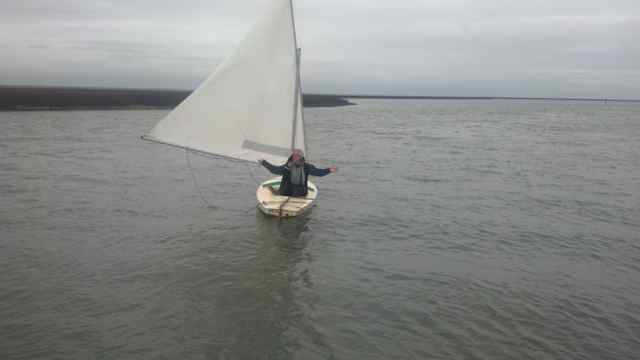
My lack of forethought in planning my return was based on my focus of getting to the island and exploring. Now I made a quick decision as to the course on the return, and a little out of the Summerhouse Creek I bore off into Bull Creek and the ferry route return. In hindsight it was perhaps a slower option than retracing the Bulls Bay passage. The tide was still falling, and with the dropping wind further diminished by sitting so low in the creeks progress was slow. The slowing increased the sounds in the creek, and three oystercatchers proceeded their passing with whistles; three more followed soon thereafter. The drone of the Bull Island surf covered the background. I found more open sailing in the southwestern branch of Andersonville Creek, beating to windward. We made a final laying of a point into the next branch, heading toward the Awendaw water tower in the distance on the mainland. Aft, a cormorant wrestled with a large fish in its bill, perhaps taking on too big of a meal.
The point of sail had turned to a reach, more slowly and quietly, but perhaps with a gain from the turned tide. Sounds were amplified in the creek. Low tide exposed the intertidal zone of the creek banks, with browns reigning from cordgrass to the armored oyster banks.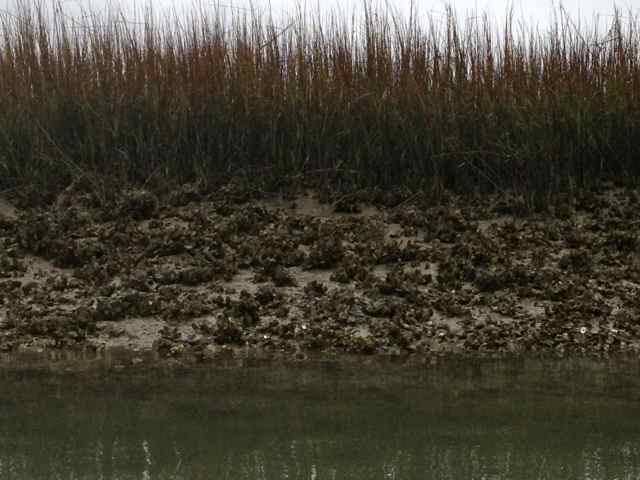 More oystercatchers whistled past, while a sole wood stork passed silently. Piercingly the plaintive sound of a loon penetrated the creek. Another sound – a fish jump, a pelican dive, or maybe a gunshot? Unclear, though the willet passing and calling was. Rails provided their echoing sounds dispersed through the marsh. Gunshots now were clear, and repetitive, coming from the mainland. And more, repeated, some generating deep chills. It was an intrusion in the creek, and threatening to extinguish the marsh magic. On the last curve, the wind was gone, and I grabbed the paddle to finish the trip, with earlier drops of rain becoming a steady drizzle. The world became completely gray once again, and moisture covered my glasses. Yet ahead I was brought to attention by action in the water, a drama stirring. A gray body slashed a dorsal fin and tail in circles close to the bank, and these appendages were joined to a dolphin, working the water and functionally corralling fish. In to the fray just a few feet above the dolphin came another large gray body – a great blue heron, landing close on the bank, seemingly looking for a little dolphin help with catching fish. Stunningly this happened just yards from the ICW, and lit up the thick gray scene. Finally, the dolphin spun its last circle, heading outward bound, and peering to its right at me it submerged on its passage through the creek.
More oystercatchers whistled past, while a sole wood stork passed silently. Piercingly the plaintive sound of a loon penetrated the creek. Another sound – a fish jump, a pelican dive, or maybe a gunshot? Unclear, though the willet passing and calling was. Rails provided their echoing sounds dispersed through the marsh. Gunshots now were clear, and repetitive, coming from the mainland. And more, repeated, some generating deep chills. It was an intrusion in the creek, and threatening to extinguish the marsh magic. On the last curve, the wind was gone, and I grabbed the paddle to finish the trip, with earlier drops of rain becoming a steady drizzle. The world became completely gray once again, and moisture covered my glasses. Yet ahead I was brought to attention by action in the water, a drama stirring. A gray body slashed a dorsal fin and tail in circles close to the bank, and these appendages were joined to a dolphin, working the water and functionally corralling fish. In to the fray just a few feet above the dolphin came another large gray body – a great blue heron, landing close on the bank, seemingly looking for a little dolphin help with catching fish. Stunningly this happened just yards from the ICW, and lit up the thick gray scene. Finally, the dolphin spun its last circle, heading outward bound, and peering to its right at me it submerged on its passage through the creek.
With the tide still quite low and mud filling the landing, I left Kingfisher at the dock until I could return later with higher water to haul her out. That evening I reviewed my photos, and looked closer at the eagle images. A splash of gold made me wonder if it was an immature bald eagle or something else.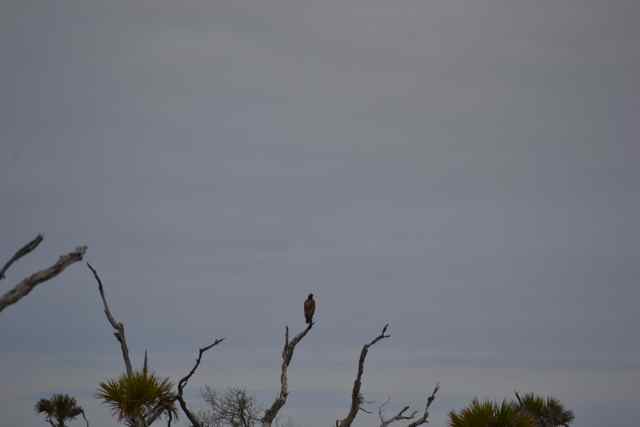 I looked at the Cornell Lab of Ornithology bird identification web, and wondered if what I had seen was a golden eagle. I looked at my old Sprunt and Chamberlain’s South Carolina Bird Life. It would have been rare but plausible. Chris Crolley looked at the image and believed it could be a golden, but felt that we should consult the Center for Birds of Prey, since this would be a rare sighting. Their director of education Stephen Schabel took a close look, and let me know it was a juvenile bald eagle. Will Christenson of Coastal Expeditions, using his imaging software to zoom in, concurred. Stephen was sorry to disappoint me, but as I reflected: could I really be disappointed by seeing a bald eagle? The observation of the raptor was just one of a number of golden moments experienced throughout that gray day.
I looked at the Cornell Lab of Ornithology bird identification web, and wondered if what I had seen was a golden eagle. I looked at my old Sprunt and Chamberlain’s South Carolina Bird Life. It would have been rare but plausible. Chris Crolley looked at the image and believed it could be a golden, but felt that we should consult the Center for Birds of Prey, since this would be a rare sighting. Their director of education Stephen Schabel took a close look, and let me know it was a juvenile bald eagle. Will Christenson of Coastal Expeditions, using his imaging software to zoom in, concurred. Stephen was sorry to disappoint me, but as I reflected: could I really be disappointed by seeing a bald eagle? The observation of the raptor was just one of a number of golden moments experienced throughout that gray day.
Great post Bob! Hope you and your family have a wonderful Christmas. Can’t wait for my next trip to Bull Island in 2013!
Stay tuned for announcement soon about the second Down the Island and Back Again.
I saw you leaving that morning on the very very high tide and wondered what your fate would be!
now I know the rest of the story
Yes, returning on the very low tide. Can’t wait to do it again.